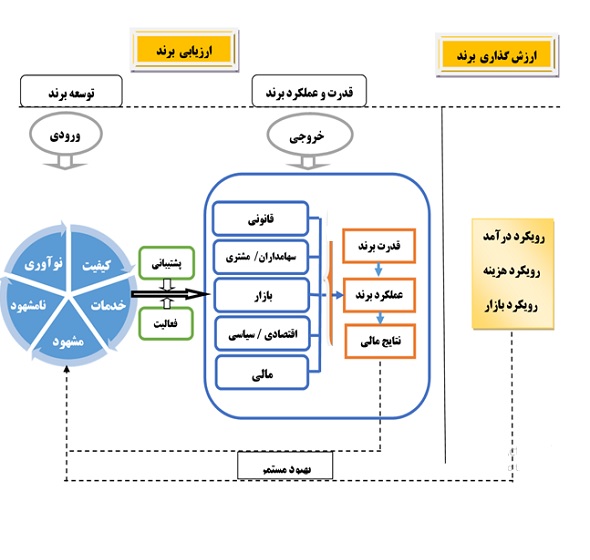Brand evaluation and valuation model
In the brand research project, a reputable company has been evaluated based on the ISO 20671 standard. This model generally has two parts of brand evaluation and valuation. According to this model, in brand evaluation two parts 1- brand development and 2- brand strength and performance are examined and in brand valuation there are three income methods. Cost and market are used.

1-Brand evaluation
Brand evaluation components include the following
1-1-Brand development:
Brand development as the first part of brand evaluation is based on the participation of five elements: Visible (tangible) factors, quality, service, innovation (technology or process), and intangible (intangible) factors. These five elements are the basis of the success of any brand
Obvious factors
Objective factors refer to identifiable and directly measurable resources that are controlled by the nature of the brand itself.
Quality factors
Quality factors refer to resources related to commitment to quality, quality management and a correct understanding of quality.
Factors related to innovation
Factors related to innovation include all resources related to activities in the field of innovation.
Service elements
The service-related factors are activities that are designed to satisfy customers with their tastes, as well as to increase the understanding of the concept and performance of the brand.
Intangible factors
Non-objective factors refer to intellectual views and strategic and cultural resources. Indicators such as historical features, cultural or traditional heritage, etc.
Brand strength and performance
Brand power is defined as the degree of influence (positive or negative) of a brand on customers and other stakeholders, which can be measured in different ways. For example, the legal power of a brand or the power obtained through consumer ratings can be used. be placed For each dimension, there are several possible indicators.
1-2-Brand power is defined as the degree of influence (positive or negative) of a brand on customers and other stakeholders, which can be measured in different ways. For example, the legal power of a brand or the power obtained through consumer ratings can be used. be placed For each dimension, there are several possible indicators.
Legal dimensions of the brand
The legal dimensions of the brand specifically include the status of brand protection and the legal scope of the brand and its ownership.
Dimensions related to shareholders and customers
The dimensions related to stakeholders and customers represent the psychological and behavioral reactions of this group.
Market size
The size of the market indicates the real and current market situation as well as opportunities to increase the growth of the brand wpml_nbsp, or structural limitations.
Economic and political dimensions around
The surrounding economic and political dimensions describe brand activities in macro environments.
Financial dimensions
The financial dimensions of brand evaluation are referred to state and internal potential brand. This information is often obtained from profit and loss calculations and tax balances, or from other financial reports of companies, cities, or regions.
2. Brand valuation
Brand valuation reflects the process of evaluating the monetary value of a brand. Brand strength and performance can be applied to a financial cash flow metric such as sales velocity or margin levels to attribute a brand’s contribution to cash flow. It provides the ultimate measure of monetary brand value. Therefore, evaluating brand performance naturally contributes to monetary brand valuation
In the 20671 standard model, there are three approaches for brand valuation, which include the cost approach, the income approach, and the market approach. The income approach is the most appropriate approach for brand valuation. In this way, the price difference of the product is calculated in two cases with brand and without brand, and by multiplying this price difference with the production amount of the product, the value of the brand is calculated. Of course, other factors should also be considered. Including product life cycle, market situation, recession, inflation and…
<!– Google tag (gtag.js) –>
… (several lines of code) …
</script>

